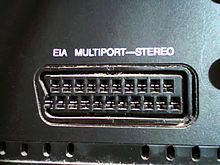Electronic Industries Alliance

The Electronic Industries Alliance (EIA; until 1997 Electronic Industries Association) was a standards and trade organization composed as an alliance of trade associations for electronics manufacturers in the United States. They developed standards to ensure the equipment of different manufacturers was compatible and interchangeable. The EIA ceased operations on February 11, 2011, but the former sectors continue to serve the constituencies of EIA.[1]
History
In 1924, United States-based radio manufacturers formed a trade group called the Associated Radio Manufacturers. Later that same year, the group renamed itself the Radio Manufacturers Association (RMA). Over time, new electronic technologies brought new members and name changes, including Radio Television Manufacturers Association (RTMA) (1950), Radio Electronics Television Manufacturers Association (RETMA) (1953) and Electronic Industries Association (EIA) (1957). The group renamed itself for the last time in 1997, when the Electronic Industries Association became the Electronic Industries Alliance (EIA), reflecting the changing membership of the group, including non-manufacturer members.
The organization's headquarters were in Arlington, Virginia. The EIA divided its activities into the following sectors:
- ECA – Electronic Components, Assemblies, Equipment & Supplies Association
- JEDEC – JEDEC Solid State Technology Association, former Joint Electron Device Engineering Council
- GEIA – (now part of TechAmerica), Government Electronics and Information Technology Association
- TIA – Telecommunications Industry Association
- CEA – Consumer Electronics Association
The EIA announced in 2007 that it would be dissolved into its constituent divisions,[2] and transferred operations soon after. The Alliance formally ceased to exist on February 11, 2011.[1] EIA designated ECA to continue to develop standards for interconnect, passive and electro-mechanical (IP&E) electronic components under the ANSI-designation of EIA standards. All other electronic components standards will be managed by their respective sectors.
The ECA merged with the National Electronic Distributors Association (NEDA) in 2011 to form the Electronic Components Industry Association (ECIA).[3] However, the EIA standards brand will continue for IP&E standards within ECIA.[4]
EIA standards
With the changing names of the EIA, the naming convention of the standards was also adapted. For example, a standard defining serial communication between computers and modems e.g. was originally drafted as a Recommended Standard,[5] thus the "RS" RS-232. Later it was taken over by the EIA as EIA-232. Later this standard was managed by the TIA and the name was changed to the current TIA-232. Because the EIA was accredited by ANSI to help develop standards in its areas, these standards are often described as e.g. ANSI TIA-232 (or formerly as ANSI EIA/TIA-232). As currently authorized, any ANSI standard designated at ANSI EIA-xxx is developed or managed by ECA (and, in the future, ECIA).
References
- ^ a b "Welcome". ecaus.org. Electronic Industries Alliance. 2011. Archived from the original on 2011-06-02. Retrieved 2011-06-02.
The Electronic Industries Alliance ceased operations on February 11, 2011.
{{cite web}}: Unknown parameter|deadurl=ignored (|url-status=suggested) (help) - ^ http://www.edn.com/electronics-news/4317670/The-fall-of-EIA-What-happened-
- ^ http://www.edn.com/electronics-news/4311980/NEDA-ECA-merge-target-counterfeit-components | NEDA, ECA merge, target counterfeit components
- ^ http://www.ecianow.org/standards-practices/standards/
- ^ EIA RS-464. Electronic Industries Association. 1981 [December 1979]. p. insert.
Recommended Standards are adopted by EIA without regard to whether or not their adoption may involve patents on articles, materials, or processes. By such action, EIA does not assume liability to any patent owner, nor does it assume any obligation whatever to parties adopting the Recommended Standard. This EIA Recommended Standard is considered to have international standardization implications, but there is no known IEC (or ISO) activity in this product area.
